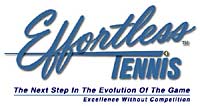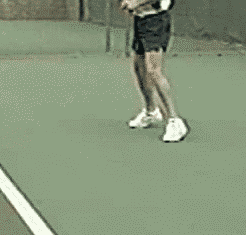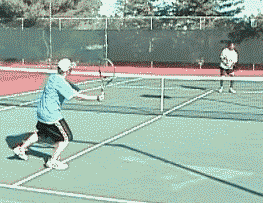<% ns_puts [mkm_getnavbar] %>

Effortless Tennis - Keys to Peak Performance
by Brent Zeller
My goal in 1974 was learning how to get and then stay “in the zone.” In part 1 of this series I spoke about what I believe to be the keys to peak performance and how removing competition from the equation can help you to achieve your true potential both on and off the court. What follows are the final six keys and the conclusion of that discussion.
Hand/Eye Coordination
To be a good tennis player takes incredible hand/eye coordination. We have to track, move to, and intercept a small, fast moving object, all within a few seconds. There are few situations in our lives where we have to react as fast as we do in tennis. Initially, no one has the reflexes or concentration needed to react fast enough to hit the ball consistently into the court. It has been assumed that hand/eye coordination was something we either had or we didn’t; for some people it does come more naturally, but most people have to learn to track the ball. It is a skill everyone can acquire. If you don’t have highly developed hand/eye coordination, getting into competition will only exacerbate the problem. If you can’t hit the ball in the center of the racquet most of the time, you should not be competing.
For as long as I can remember, I have always had great hand/eye coordination. In the process of writing this paper I remembered one event from my childhood that helped me understand why I had this skill. My dad put down a load of small stones along the path that we drove up to our mailbox. I was less than ten at the time. One day I went over and used these stones for batting practice. The bat was about 2 feet long and had a circumference of barely more than one inch; the stones were small also, the biggest of which were about the size of a nickel. I spent hours trying to hit those stones. If I didn’t really watch the stone, and know where my bat was, I would miss. At first I missed a lot, but then I started getting the feeling of what I needed to do, and I started making contact much more frequently. My great hand/eye coordination, was not some gift I possessed, but something I had worked at to create. I was just playing, but I was also learning how to track a moving object. At some point tracking the ball became part of my cellular memory.
This is the same reason that people like Michael Jordan or Tiger Woods do
so
well; yes they are very naturally talented, but they practiced a lot when
they were young. It’s not magic. Hand/eye coordination is a learned skill
that everyone can acquire eventually. It will take some people longer than
others, but I have seen no one that kept practicing that didn’t learn how
to
track the ball sufficiently to succeed.
Keeping our eye focused on the ball is really a matter of keeping our mind
focused on the ball. So this goes back to key number 3, concentration. It
is
our mind that leaves the ball, thereby turning off the connection to our
eyes. The old saying, “you can’t hit what you can’t see” is applicable
here. When players are immediately thrown into competition they do not
have
the level of hand/eye coordination needed to sustain a rally, let alone
win a
match. We can’t expect people to come out on the court and start
competing,
if they can’t track a fast moving object. This is where everyone starts to
tighten up around performance; not being able to track the ball increases
the
number of unforced errors people commit, which then decreases performance.
At
a certain point, taking their eye off the ball just before contact becomes
part of their cellular memory. In the nurturing confines of Effortless
Tennis, players are able to increase their hand/eye coordination and
reaction
time profoundly over the course of time, and also undo old cellular memory
that had them not tracking the ball. Eventually we can track the ball
without
having to think about it.
Stroke Mechanics & Footwork
There are dozens of different ways we can swing the racquet and move our feet to get to the ball. If we look at the pros, we see many different styles of hitting and moving. The thing is that unless someone plans to practice as much as the pros, they should not expect to be able to move and hit the ball like the pros. The only reason the pros can move and hit the way they do is because they have been practicing six hours a day over at least the last ten years of their lives. They are not getting out for an hour or two once a week.
|
|
Even though there are many ways to hit the ball and move our feet, there
are
more or less efficient ways to hit and move. On many balls we have to
hit, there are fractions of seconds between success and failure. We need
efficient movements to be able to react quickly enough on these fast
moving
balls. Developing more efficient strokes and footwork is something we work
on
for as long as we play the game. Over the years we will continue to shave
a
few fractions of seconds off of what we are doing.
In premature competition, because players haven’t learned the movements
and
reactions necessary to execute the shots, they ingrain less than efficient
stroke and footwork patterns into their cellular memory, thereby limiting
how
quickly they can react and move. Everything is happening so fast that we
don’t have time to think, we are just trying to survive. Again I must
reiterate, reprogramming less than efficient stroking and footwork patterns
is
virtually impossible to accomplish in competition, because, what is most
deeply programmed into the cells is what will come out every time under
pressure. In a non-competitive environment players are able to take the
time
to develop their strokes and footwork so that the patterns that they
ingrain
are efficient and effortless.
Just as there are most efficient stroking patterns there are also most
efficient footwork patterns. We can position our feet in many different
ways,
but some ways will work better than others to provide us with the best
opportunity to hit our best shot, and these are the positions we want to
pattern into our cellular memory. Any time we are playing we want to take
as
few steps as necessary, because this saves energy, and after we have been
playing for an hour or more, those extra steps will take their toll on our
stamina. At the higher levels of the game players don’t have time to take
even one extra step; on certain shots, one extra step will make it
impossible
to get to the next shot. Over the course of our involvement with the game,
we
need to continue to refine our footwork, it is another long-term project.
Tennis is a spontaneous, improvisational dance. We are dancing, but until
the
person hits the ball, we never know where we are going.
Another aspect of footwork is weight transfer. In order to hit a solid
shot
it is necessary to transfer our weight into the ball, from our back foot
to
our front foot, at the ideal contact point, and at the ideal moment in
time.
Weight transfer provides us with a powerful shot without having to muscle
the
ball to generate that power. However we move to the ball, when we are in
the
process of striking the ball, it is optimal for our weight to be
transferring
forward toward the ball. Because we must move our feet so quickly when we
are
hitting with someone, it is easy to feel like we have lazy footwork. This
is
actually just something we have to gradually “get up to speed.”
Getting
to the ball is the first thing we need to do, being able to transfer our
weight into the shot comes later, but to hit our best shot, it must
happen.
Rhythm
There is a rhythm to playing anything. We need good rhythm to be a good tennis player. First we need to find and develop our own rhythm, then we can learn how to develop rhythm with another player. Developing our own rhythm is a long term project . When we start competing too quickly, we don’t develop a secure rhythm of our own, and this creates uncertainty in us. Unfortunately, in a competition the goal is to do everything to keep opponents “off their rhythm.” We don’t want them to get their rhythm because this means that they are going to play well. No matter what most people say, they don’t want the other player to play his/her best. People want their opponents to play their best only if they still win, otherwise they are doing everything they can to not let them play their best—to not let them find their rhythm. In the Effortless program, since we are trying to sustain the rally, we are developing our own rhythm while we are learning how to be in rhythm with another player. It is great fun to get into a good rhythm with another player. In this environment you want your partner to hit great shots. To get “into the zone,” and play to our potential, we need to be “in rhythm.”
|
|
Good rhythm means good timing, and as the saying goes, “timing is
everything.” It is true. There are many moments when we can contact the
ball,
but there is one ideal moment in time to hit each shot. The closer we get
to
that moment, the better our shot. A tenth of a second is a long time in
tennis, and sometimes when we are off by that little fraction of time, it
is
too much. Just as we do not want to be late when hitting a shot, we don’t
want to be early either. To generate
maximum
velocity with minimum expenditure of energy requires contacting the ball
at
that one moment when the ball is at the ideal contact point. As people’s
skills develop, they are better able to see and stay focused on the ball
so
that they are better able to time when to hit the shot. Timing is
interrelated with hand/eye coordination and concentration. To be able to
contact the ball at the ideal moment in time, you must be able to track
the
ball and stay focused on the ball simultaneously.
In competition everything is happening so fast that it is impossible to
learn
the proper timing. We are always rushed and many times we end up being
late.
If we can first learn what it feels like to hit the ball at the ideal time
without any pressure, then we can transfer that skill to higher pressure
situations in the future. If we can’t hit the ball at the ideal moment
when
there is no competition, we can’t expect that miraculously we will somehow
time it perfectly in competition. If that happens, it is called luck.
Breathing
The art of breathing is the difference between playing well, and being “in the zone.” The skill of breathing while playing is often overlooked by most players and many coaches. Regulating our breathing allows for more efficient use of our energy. Most people hold their breath when they are hitting the ball. They are so busy trying to hit the ball they forget to breathe until they are gasping for air. Holding our breath at contact means we are tightening too many muscles as we are hitting the ball. It seems like tightening our muscles would create more power, but what happens actually is that the tightening decelerates the racquet thereby diminishing our power. One of the things most of us do while playing, is run more energy through our system than we need to in order to perform our best. I believe this is also a result of the competitive learning system; we are running too much energy because it seems like we don’t have enough time, and we are nervous about not doing well. Nervousness wastes energy. Breathing helps save energy.
Over the last fifteen years or so exhaling on contact has been championed
by
many of the mental training experts in the game. They would usually
recommend
a forceful blowing out of the breath. This is when we hear players
grunting
as they hit the ball. Exhaling on contact is very important for timing and
concentration, but ideally it should be a very soft exhale that enables
our
shoulders, arms, neck, and face to relax. When we exhale, our upper body
naturally relaxes. To illustrate the softness we want on the exhale, I
like
to use the analogy of seeing the tennis ball as a cupcake that has one
candle
on it. We want to blow out that candle, and because it is just one candle,
it
doesn’t take much breath to extinguish it. If someone is breathing out too
forcefully it is an indication of too much tension.
The new piece of the puzzle on breathing from Effortless Tennis is learning to start inhaling at the moment our partner, formerly adversary, contacts the ball. Precisely when our partner contacts the ball we start a nice, soft inhale as we move to the ball. We continue to inhale until we softly exhale as we contact the ball. The exhale happens precisely at the moment of contact, not just before or just after. The exhale continues until our partner again contacts the ball, when we again begin to inhale. Getting into this breathing pattern allows us to enter “the zone.” It puts us into a meditative state that allows our body to do what we have to, without having to “think” about what we are doing. We are now playing “out of our minds.” The skill of breathing is also interrelated to our relaxation, concentration, hand/eye coordination, and timing. Breathing enables us to relax our muscles further, keep ourselves focused on the ball better, and also improve our timing. Having these previous skills developed allows us the freedom to just breathe. In the end that is what it gets down to, breathing. We inhale, we exhale, we hit great shots, and we have fun.
|
|
Confidence
Confidence is the final key to peak performance. Everyone knows we need
confidence if we are to be good at something, but it seems as if, in this
society, we are supposed to have confidence in what we are doing, even
before
we know how to do what we are doing. I don’t see how it works like that.
If
we are not sure we are going to be able to get to the ball and hit it back
in
the court, we are decreasing our chances of making the shot. Confidence
does
not come from some false bravado, but from an internal knowing that we
have
the skills necessary to be successful. The competitive system promotes
“faking” confidence so that we can fool our opponent, and hopefully
ourselves, into thinking that we are better than them; this will lower
their
self-confidence, increase their self-doubt and improve our chances of
winning. This only works up until the other person has the necessary
ability
and can call our bluff. For the long-term, faking confidence doesn’t work.
It is hard to develop secure confidence while learning in a competitive
learning system, because there is always another contest—even if we won
the
last one, there is someone still wanting to beat us. If we know “inside”
that we don’t have the skills, or aren’t certain that we have the skills,
our confidence will be tentative. This whole process started when we were
very young. Our coaches, teachers and parents told us to be confident,
“you’ve got to be confident” they said, but even as little kids we knew, on
some level, that we couldn’t be confident because we weren’t sure what we
were supposed to be doing. When you don’t know what you are doing, it is
impossible to be confident. So telling someone who has lost many times to
be
confident, is only further lowering her/his confidence. Looking back on my
competitive playing career I had serious confidence problems, and I did
pretty well in competition. Now I understand why my confidence was not
strong, I should not have been playing competition—I hadn’t mastered the
fundamentals. If we do not have a deep inner confidence in our skills, we
are
not going to be able to perform well under pressure.
In the non-competitive Effortless system, as we develop the other 12 keys
to
peak performance, our confidence will get stronger and continue to grow.
Confidence is the end product of developing the skills—it is not where
we start. Only a fool is confident when he isn’t sure he knows what he is
doing. It takes a lot of time and work to develop true confidence.
Confidence
comes from doing the work and knowing that we know what we are doing.
To contact us, please email to: webmaster@tennisone.com
TennisONE is a registered trademark of TennisONE and SportsWeb ONE; Copyright 1995. All rights reserved.



